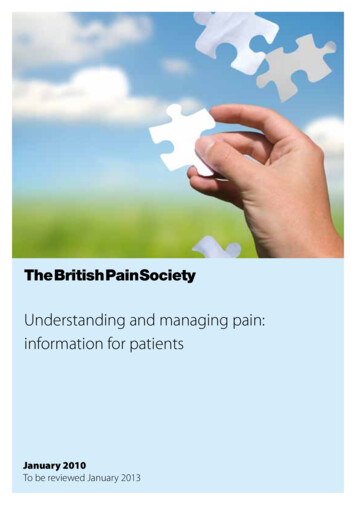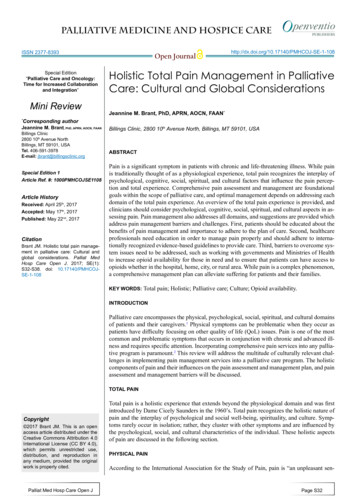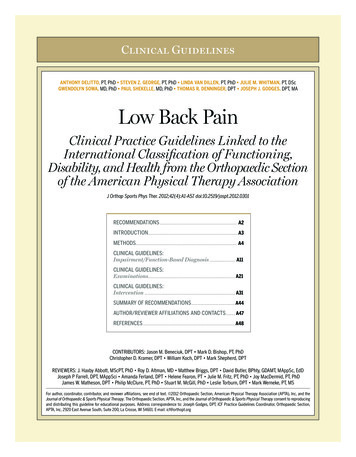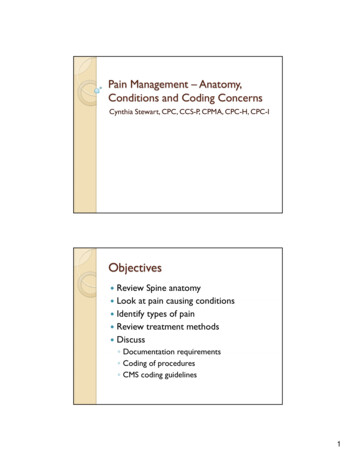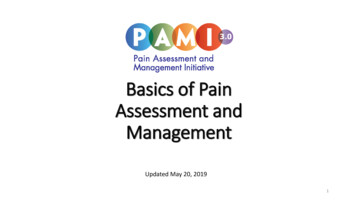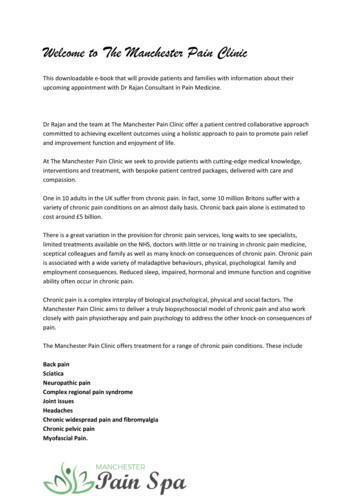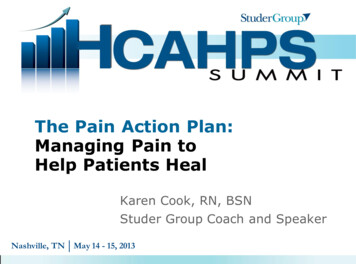
Transcription
The Pain Action Plan:Managing Pain toHelp Patients HealKaren Cook, RN, BSNStuder Group Coach and SpeakerNashville, TN May 14 - 15, 2013
ObjectivesImprove the patient perception of pain as measuredby the HCAHPS composite Pain Management:“How often was your pain controlled?”“How often did the hospital staff do everythingthey could to help you with your pain?”Identify how to use Evidence-Based Leadership asa problem-solving frameworkUnderstand best practices to “help patients heal” bymanaging painCopyright Studer Group. Please do not quote, cite, or disseminate without Studer Group authorization.
The ‘Why’Pain control is a fundamental human need (Maslow)90% of all disease may be associated with pain100 million Americans have chronic painTens of millions undergo surgery or procedure thatcauses pain each yearMost common reason that patients visit the ED,physician office, and pharmacies 120 billion spent each year due to pain75% or more hospital patients hurt and suffer morethan they shouldCopyright Studer Group. Please do not quote, cite, or disseminate without Studer Group authorization.
Comm with Nurses, Response, Pain OverallThis dimension has a screening question, is highlylinked to overall perception and very subjective.Copyright Studer Group. Please do not quote, cite, or disseminate without Studer Group authorization.
Organizations Coached by Studer GroupOutperform the Nation across HCAHPSCompositesNewUpdate!3Q11-2Q12Studer Group Difference over Non-Partnersin National Percentile RankingOverall RatingWillingness to RecommendPain ManagementNursing CommunicationCommunication of MedicationsClean and QuietDischarge InstructionsResponsiveness of StaffDoctor 10505101520Studer Group Difference over Non-PartnersinNationalPercentileRanking25Source: The graph above shows a comparison of the average percentile rank for Studer Group Partners that have received EBL coaching since Oct 2008 andnon-partners for each composite; updated 5.2.13 using 3Q11-2Q12 CMS data.Copyright Studer Group. Please do not quote, cite, or disseminate without Studer Group authorization.
Who Does it Well Pain ManagementTop 10 Organizations in AttendanceData Based on 2Q11-1Q12 CMS Update, by Discharge DateCopyright Studer Group. Please do not quote, cite, or disseminate without Studer Group authorization.Studer GroupPartners in Teal*90th %tile is equivalent to top box score of 77
Definition of Pain“Pain is an unpleasant sensory and emotionalexperience associated with actual or potentialtissue damage or described in terms of suchdamage” (IASP, 1979)“Pain is whatever the experiencing person says itis, existing whenever he/she says it does”.Margo McCaffery RN, MS, FAANCopyright Studer Group. Please do not quote, cite, or disseminate without Studer Group authorization.
The Voice of the Patient“How often was your pain Well Controlled”Find out what well controlled means to meInclude me in setting goals and educate meFind out how long pain medicines lastBe on time with pain medicine so I don’t get behindAsk me what has worked for me in the past“Staff do everything they can to help control pain”Learn my tolerance and what I take at homeDon’t assume I am an addict or worried about being oneUse various positioning for added comfortProvide complimentary alternatives (guided imagery, etc.)Copyright Studer Group. Please do not quote, cite, or disseminate without Studer Group authorization.
Execution FrameworkEvidence-Based LeadershipSM (EBL)FoundationSTUDER GROUP :ObjectiveEvaluationSystemLeaderDevelopmentAligned GoalsDevelop goals tocreate urgency,focus orawareness of thedrive to improvePain domain inHCAHPSEducate leadersand staff withskills andcompetenciesnecessary toachieve theresultsMustHaves PerformanceGapAligned BehaviorReward andrecognize orNurse Leadercoach/counselRoundsas appropriate toHourly Rounding reinforcebehaviors andFollow up Phoneachievement ofcallsresultsKWKTHuddlesCopyright Studer Group. Please do not quote, cite, or disseminate without Studer Group authorization.Standardization AcceleratorsAligned ProcessProcesses thatare consistentand standardizedProcessImprovementPDCALeanSix SigmaBaldrigeFrameworkSoftware
Set Measurable TargetEvidence-based Practice:Set an objective goal for allrelevant evaluationsNational averageAlways71%Usually22%Some/Never 7%VBP Benchmark – 77.92%Copyright Studer Group. Please do not quote, cite, or disseminate without Studer Group authorization.ObjectiveEvaluationSystem
Build Skill and Audit ActionsLeaderDevelopmentEvidence-Based Practice: Include interdisciplinaryteam in pain control education specific to unitAll employees to focus on patient comfort and perceptionof pain (PT, OT, Transport, etc.)Physician support of pain management strategiesBarriers to pain control– Staff inadequate ability to assess pain– Staff personal biases and judgments– Patient unwillingness to verbalize pain or take medicineAppropriate use of pain assessments, PCA Pumps, etc.Clinical specialists – resource nursesCopyright Studer Group. Please do not quote, cite, or disseminate without Studer Group authorization.
Key Words – Convey EmpathyMustHaves How do patients know we care about pain control?“I want to do everything I can to keep you as comfortableas possible.”“Keeping your pain managed is important. Tell me aboutyour pain right now.”“I understand it hurts to walk but getting up helps keepyou from getting a blood clot ”“We want you to be more comfortable and our goal is toreduce your pain to a manageable level.”“Your pain is now being controlled with 3mg rather than6mg of medication so you are closer to going home.”Copyright Studer Group. Please do not quote, cite, or disseminate without Studer Group authorization.
Validate Key Words in Nurse LeaderRoundingMustHaves How do nurse leaders know patients feel like we arealways doing everything we can to help?“Tell me about some of the suggestions Karen has offered youto help control your pain.” (look for alternative modalities – notjust the pain medicine)“We want to give you enough medication to keep youcomfortable but still keep you able to participate in yourphysical therapy, can you tell me what a manageable paincontrol goal would be for that”?“I see Karen has put ‘pain control’ on your board as your goaltoday, how well are we doing with that?”“It looks like Tonia was just in for hourly rounds, can you tellme some of the questions she asked you?”Copyright Studer Group. Please do not quote, cite, or disseminate without Studer Group authorization.
Utilize Care/White Boards to EngagePatient/Family in Pain ManagementMustHaves Best Practice: “Manageable” pain goal (1-3) establishedand written on the patient care board (100%)We want to give you enough medication to keep you comfortable butstill keep you able to participate in your physical therapy, can you tellme what a manageable pain control goal would be for that”?“You are going to have surgery so you will have more pain tomorrowthan you do today. What would you have said your manageable paingoal was at home before surgery?”“I know Dr. Cook told you that you would be pain free, but if you werecompletely pain free, you might be too tired to walk and then you will beat risk for a blood clot and we don’t want that.”“Since you are not taking any pain medicine on a regular basis, I amgoing to put a smiley face in the goal box. That will let our team knowthat you are not having any pain and you are not taking any painmedicine. But make sure and let us know if anything changes.”Copyright Studer Group. Please do not quote, cite, or disseminate without Studer Group authorization.
Copyright Studer Group. Please do not quote, cite, or disseminate without Studer Group authorization.
Validate Through Care Board AuditsCopyright Studer Group. Please do not quote, cite, or disseminate without Studer Group authorization.PerformanceGap
Evidence-Based PracticeImplemented Care BoardAudits in the 3rd Quarter1009080807472 727882706075756559656255 56561st Qtr502nd Qtr403rd Qtr3020100Rate hospital 9 or10Communicationwith NursesCommunicationwith DoctorsSource: Allegiance Health, Jackson, MICopyright Studer Group. Please do not quote, cite, or disseminate without Studer Group authorization.Pain ManagementCommunicationabout Medicines
MustHaves Hourly RoundingEvidence-Based Practice: Hourly Rounding withdocumentation on hourly rounding log.Re-assess pain control at peak time post administration (if stillin pain 1-1.5 hrs later)Have to document rounds hourly already if on PCARounding affected the 3 P’s: Pain (-35%)30002500 Potty (-40%)2,379 Position 3615000BathroomCopyright Studer Group. Please do not quote, cite, or disseminate without Studer Group authorization.PainPositioningPre-RoundIV/AlarmsEnd RoundMisc
Bedside Shift HandoverMustHaves Evidence-Based Practice: Engage the patient andtheir family in discussion about pain control at shiftchange. Connect the dots that hourly rounding is astrategy to help them manage their pain.Pain control and goals should be in all reportsEnsure patient has full understanding of dosing– PCA pumps– Adjuvant therapyUse teach-back to ensure understanding ofmedication actions and side effectsCopyright Studer Group. Please do not quote, cite, or disseminate without Studer Group authorization.
Focused Safety HuddleMustHaves Evidence-Based Practice: Daily safety huddle (bycommunication boards) includes hard-to-control painpatients ie. PCA pumps, referral to Pain ResourceNurse, etc.Copyright Studer Group. Please do not quote, cite, or disseminate without Studer Group authorization.
Validate Through Nurse Leader RoundsPerformanceGapEvidence-Based Practice: Nurse Leader Rounds –use the rounding framework to ensure best practicesare in place and creating the impact we expect.Sample questions:“Since I was here yesterday, have you needed to useyour call light to request pain medication?”“I see your whiteboard is up to date with your next painmedication available. Since I was here yesterday, has itbeen kept up to date 100% of the time?”Copyright Studer Group. Please do not quote, cite, or disseminate without Studer Group authorization.
Standardize the ProcessStandardizationEvidence-Based Practice: Initial Pain Assessments andSharing of Patient-Centered Pain Control InformationCopyright Studer Group. Please do not quote, cite, or disseminate without Studer Group authorization.
Standardize Use of The ToolsStandardizationBest Practice: Keep pain control top-of-mind awarenessthrough multiple communication channelsCopyright Studer Group. Please do not quote, cite, or disseminate without Studer Group authorization.
Pain Control in All AreasCopyright Studer Group. Please do not quote, cite, or disseminate without Studer Group authorization.Standardization
Acute Pain in the Chronic Pain PatientStandardizationEvidence-Based Practice: Develop protocols and treatmentregimens for the most challenging patients.Contracts for chronic pain patientsProcess for reviewing all unresolved pain eventsConsults with Pain Management ExpertsCopyright Studer Group. Please do not quote, cite, or disseminate without Studer Group authorization.
Share Your IdeasCopyright Studer Group. Please do not quote, cite, or disseminate without Studer Group authorization.
References1.2.3.4.5.McCaffery, M., & Pasero, C. (2000). How to choose the bestroute for an opioid. Nursing, 30(12), 34-40.Ashenbrenner, D.S., et al. (2002). Drug therapy in nursing.Philadelphia: Lippincott Williams & Wilkins.Hazelett S., Powell, C., & Androulakakis V. (2002). Patients'behavior at the time of injury: Effect on nurses' perception ofpain level and subsequent treatment. Pain ManagementNursing, 3(1) 28-35.Drugs for pain. (2000). The Medical Letter on Drugs andTherapeutics, 42(1085), 73-78.Passero, C., McCaffery, M., & Gordon, D. (1999). Buildinstitutional commitment to improving pain management.Nursing Management, 30(1), 27-33.Copyright Studer Group. Please do not quote, cite, or disseminate without Studer Group authorization.
Nashville, TN May 14 - 15, 2013 The Pain Action Plan: Managing Pain to Help Patients Heal Karen Cook, RN, BSN Studer Group Coach and Speaker . . completely pain free, you might be too tired to walk and then you will be at risk for a blood clot and we don't want that."





